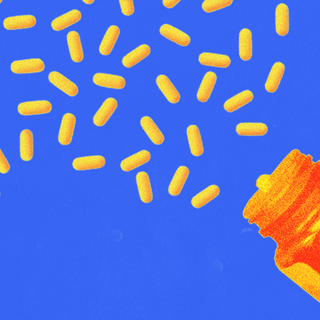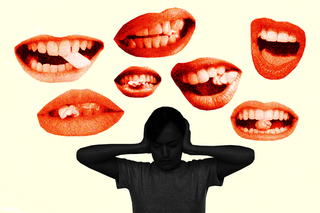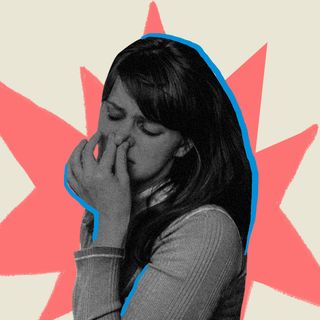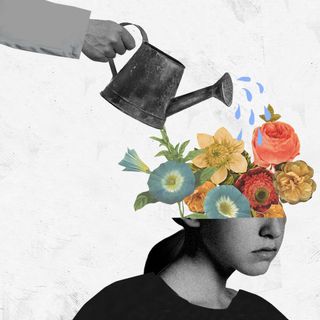
Why Foot Tapping or Chewing Sounds Make Some People Anxious
For people with misophonia, specific sounds can trigger emotional or physiological responses including irritation and panic.

A slurp, a pen tapping, or loud breathing are not always harmless sounds. For some people, these auditory triggers can lead to strong emotional or physiological responses. This condition, called “misophonia,” captures an intense disgust and intolerance of some specific sounds.
It is hard to describe what constitutes a trigger sound but think of the grating feeling that washes over people when they hear nails on chalkboards. The memory of the screeching itself tips violent, inexplicable anxiety. Any trigger is, as Dr. Barron Lerner, an NYU professor calls, “awful.” “Like your blood is starting to boil. [There are] lots of anxious feelings, like heart racing and stomachache,” he told Healthline. Research has shown people may feel anxiety, rage, and panic.
“[My roommate] was chewing a banana with her mouth wide open, smacking it around and making it sound so slimy and vile,” a Reddit user explains the condition. “I’m not just slightly uncomfortable, I end up wanting to get very violent with the person performing said trigger even if they’re the nicest person I’ve ever met, and I occasionally end up hitting my head and crying for hours after I leave the situation.”
Misophonia was first named as a condition in 2001. Since then, research about causes and specific reasons has emerged slowly but is still evolving. What is known so far is misophonia is both — a physiological and psychological condition. A 2019 research published in Natureshowed misophonia is associated with altered brain activity. Scientists have also hypothesized that the condition is triggered by the brain’s overprocessing auditory cues, such as slurping or chewing. “Specifically, the parts of the brain responsible for long-term memories, fear, and other emotions were activated. This makes sense since people with misophonia have strong emotional reactions to common sounds. Their responses demonstrate that these parts of the brain are responsible for the experience of misophonia,” the researchers noted.
In June this year, scientists zoomed in on a “breakthrough” study about misophonia that partly explained the biological aspects. They ascribed some forms of misophonia to a “mirroring” effect, where the brain mimics the distress of triggering mouth movements. To show this, a research team analyzed brain activity in people with and without misophonia when they were at rest and while they listened to sounds. The researchers subjected participants to three types of auditory cues: misophonia triggers, generally unpleasant sounds (like a crying baby), and neutral sounds. “People with misophonia showed stronger connections between the auditory cortex and brain regions that control movements of the face, mouth, and throat,” Scientific American explained, adding this connection became most active when people heard the triggers for misophonia.
Related on The Swaddle:
Why Seeing Others Fidget Is Stressful for Some People
Despite some advancements in recent years, research into misophonia is relatively new. It is not yet included in the Diagnostic and Statistical Manual of Mental Disorders (DSM-5); some experts have called for including it under “Obsessive-Compulsive and Related Disorders.”
Some distinct characteristics of the condition based on current findings are based on genetics. Scientists hypothesize that it may run in families, and onset is generally before puberty between 9 to 12. Initial triggers originate within the family; for instance, the sound of a parent or teacher may be the first auditory sign of distress. The scope of triggers may vary and expand with time.
Some studies have shown that misophonia is more common among people with anxiety disorders, obsessive-compulsive disorder, Tourette syndrome, even tinnitus. “Lots of people who have these other things have misophonia, and the symptoms they generate are similar. For example, an anxious person with misophonia might get the similar heart racing, sweating, etc., from a stressful situation at home or work as with hearing a particular noise,” Dr. Lerner noted.
One obstacle to addressing misophonia is that of lacking awareness. It is often clubbed with other conditions, further pushing the peculiarities of misophonia away from the mainstream.
Recognition and research are both vital to addressing the condition. The impact can be wide-ranging. It can lead to isolation, as people avoid trigger sounds and opt out of social situations. The “flight-or-fight” response can impair daily lives, compromising mental health. Experts note it can lead to avoidance and even depression.
“It’s like a tsunami of negative responses,” Dr. Marsha Johnson, an audiologist with the Oregon Audiology Clinic, told Healthline. “It’s instant. It’s huge. It takes over most of their cognitive functioning.” Researchers of the 2021 study also add the negative consequences are linked to a sense of loss of control, invasion of personal space, or interference with current goals and actions.
Potential treatments of misophonia can include cognitive-behavioral therapy, counseling, and practicing mindfulness. “Therapies could build on the new findings by counseling patients about handling unconscious motor responses to triggering sounds—not just coping with the sounds themselves,” Fatima Husain, a University of Illinois professor of speech and hearing science, told Scientific American.
Saumya Kalia is an Associate Editor at The Swaddle. Her journalism and writing explore issues of social justice, digital sub-cultures, media ecosystem, literature, and memory as they cut across socio-cultural periods. You can reach her at @Saumya_Kalia.
Related


Migraine Patients Often Suffer from ‘Osmophobia’ or the Fear of Smells: Scientists
